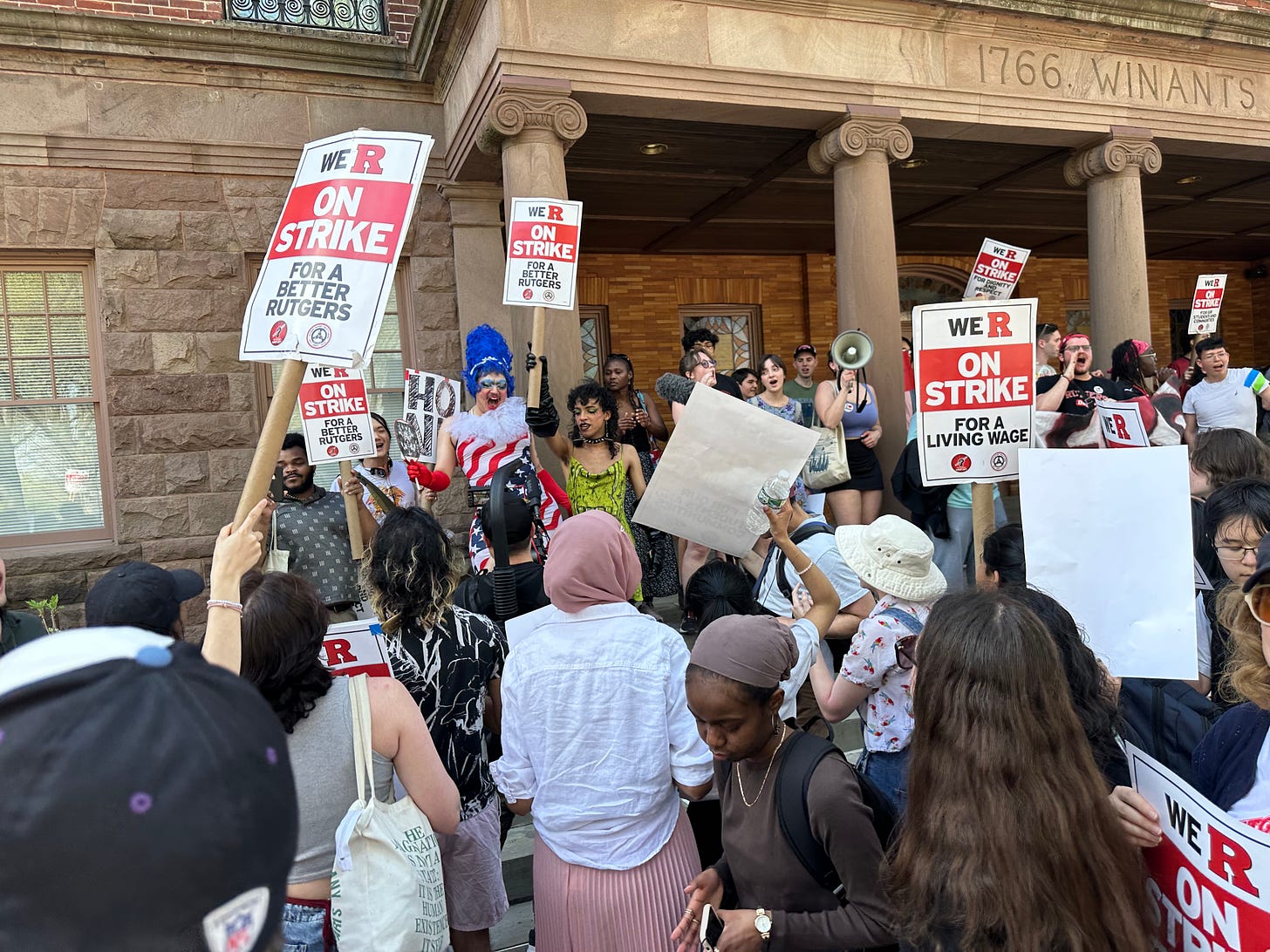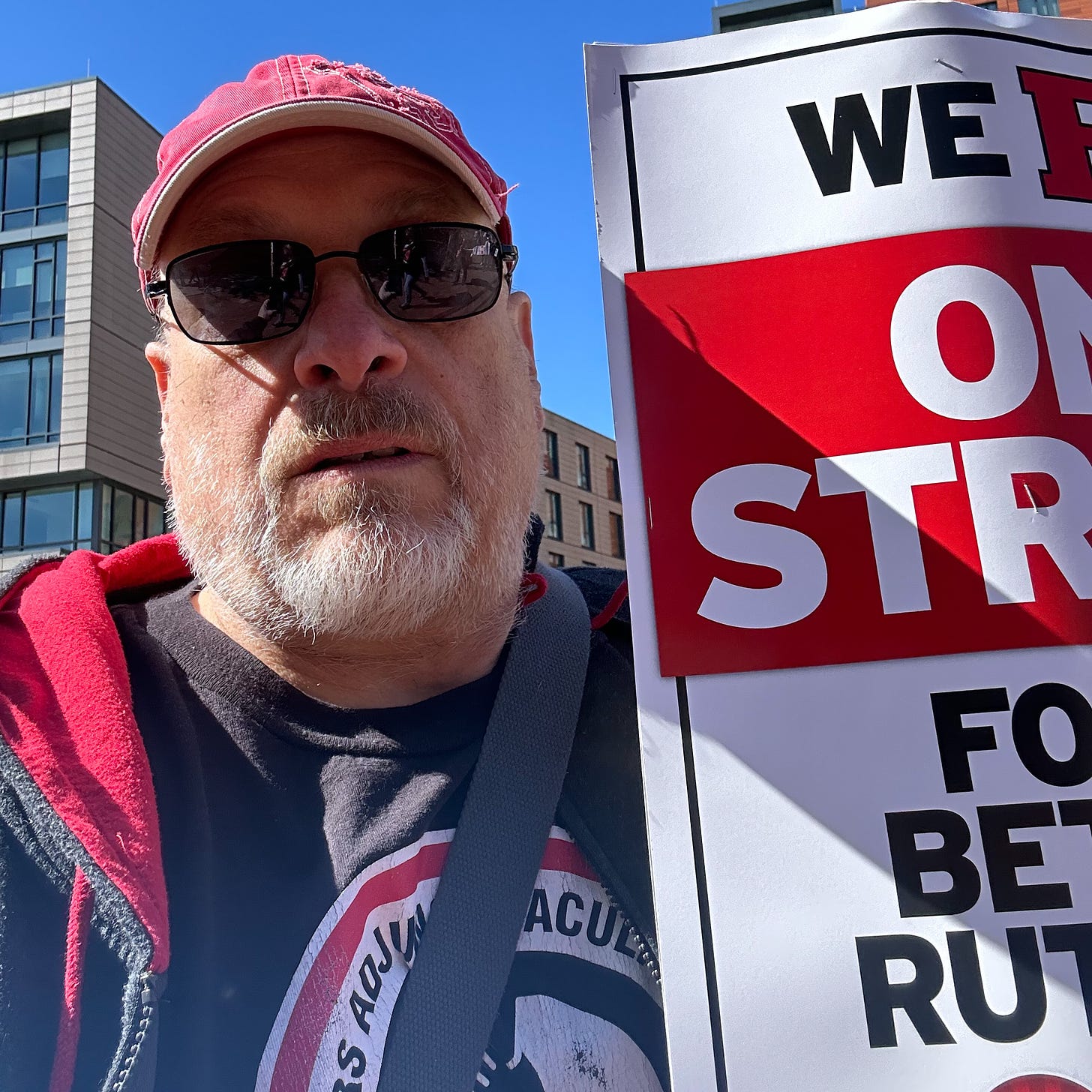This space was here to lend a voice to the 48,000 academic workers from the University of California system who started their strike on November 14th. Graduate student workers remained on the picket line for nearly six weeks before voting yes to an agreement on December 23.
This group of UC employees was not the first or the last collective of academic workers to strike, but their struggle has become a model for other academic union campaigns. The Higher Education Inquirer has been in solidarity with this effort for economic justice, where unfair labor practices are commonplace and systemic.
The outcome of the long University of California strike was a solid victory for democratic action--but not surprisingly, some of the most vulnerable workers received the least in return for their efforts.
There were many takeaways--
lessons learned--in this long fight--a fight that was years in the making--and that must continue. Imagine if adjuncts, students, rank-and-file workers, organized labor, and other related communities fought just as hard (and smart) to reduce homelessness, hunger, hate and violence, debt, and precarity.
Elite Universities and the Systematic Exploitation of Labor
US mainstream media have rarely acknowledged the plight of non-tenured academic workers--who go by a number of titles. This precariat teaches undergraduate students and does much of the research at universities, including elite US universities, for modest wages and limited job security.
While elite private and public schools have gained enormous power and wealth, many contingent academic laborers often struggle just paying their bills. Grad student workers have shared stories of
living in their cars, commuting long distances, and enduring other
hardships while working through school.
In order to get economic justice, academic workers have struggled for union representation and equitable labor contracts--with limited results.
The original strikers consisted of four bargaining units with about 48,000 workers:
*Academic student employees (teaching assistants/readers/tutors) UAW2865
*Graduate student researchers SRU-UAW
*Postdoctoral scholars and Academic researchers UAW5810
Image from Fair UC
Workers versus Elites
At the first draft of this article (11-20-22), the union and their bosses, the
University of California Regents, were far from a settlement. We expected UC officials to engage in a variety of anti-union strategies despite claims that they were bargaining in good faith. True to form, that's what happened.
Mainstream
local media attention has occurred, but few sources
have given much thought to the history of politics, academic power,
and wealth--and their links to poor labor conditions: long and irregular hours, low-wages, and wage theft at University of California campuses.
Organized workers in the UC system have also had to fight systemic harassment and intimidation, systemic racism, and threats of deportation. In the not-too-distant past, UC workers claimed the UC system spent millions of dollars on union busting firms and employed "activist response teams" that included police officials and administrators to watch striking workers.
Governor Gavin Newsom and the 18 Regents of the UC system represent the major political and economic interests of the State of California--and the adversaries of labor. In this situation they have an enormous amount of power but were mostly invisible to the media.
California History
According to University of California Santa Barbara labor historian
Nelson Lichtenstein, about 10 percent of the UC's budget is funded by
the State of California, down from more than 50 percent in its peak year, 1963. Other elite universities have replicated this model.
Californians have also experienced growing inequality (including high rents and college tuition) for more than a half century, since the rise of Ronald Reagan (1967-1975) and the movement to reduce taxes and defund higher education.
During Reagan's second term as Governor of California, a 1973
California Supreme Court ruling opened the floodgates for landlords to
charge unaffordable rents.
Proposition 13 (1978), which limited residential and commercial property taxes, added insult to injury. And Proposition 209 (1996) was a near fatal blow to equality and social justice in the Golden State.
Labor and the UC System
UAW Local 2865, the union of teaching assistants, graduate student instructors, tutors, and readers in the University of California system was formed in 2000. UAW 5810, the union of postdoctoral scholars and academic researchers, was formed in 2008.
By 2018, UAW 2865 grew
to majority membership statewide and won a new contract with new rights in
several areas.
In July 2021, the UC system boasted that it had grown to $168 Billion in assets. Four months later, 6,000 UC part-time lecturers prepared to strike for better wages and more stability. Median wages for the contingent lecturers were $19,000 a year. The settlement between the UC system and University Council-American Federation of Teachers (UC-AFT) called for a 30 percent increase in wages over 5 years with promises of more stability.
UAW 2865 has attempted to negotiate with the UC system--who for weeks offered concessions that would not even cover inflation. Worker salaries vary, but some make as little as $24,000 a year, in cities like San Francisco and Los Angeles, where housing is extremely unaffordable.
Bargaining for a Fair UC document lists worker proposals and UC's proposals.
The 2022 Strike
As the strike has developed, the system has employed a number of tactics, including divide and conquer actions and a number of appeals to
the media and the public. We expect the
mainstream media to side more with the system it serves rather than the
people who do the hardest work but get the lowest pay.
Initially, many senior faculty and other unions serving the University of California refused to cross picket lines in solidarity with the UAW strikers.

Stanford University marching band spells out "UAW" during Stanford-Cal
football game on November 19, 2022 at California Memorial Stadium.
Image courtesy Rafael Jaime, President of UAW 2865.
Second week of the strike. UC workers at the University of California, San Diego, November 21, 2022
Week 3 of the strike. UC workers at UCLA, November 27, 2022
On November 29th, the UAW 5810 gained a tentative agreement and received significant wage increases for postdocs and academic researchers--12,000 of the 48,000 workers. Meanwhile, the UC system had made no additional concessions to lower status graduate student workers.
On November 30, UC officials made few concessions to the graduate students. Student Researchers United (SRU) and UAW 2865 bargaining teams made major concessions, to include:
- Dropping dependent healthcare coverage completely
- Dropping the childcare subsidy from $6,000 per quarter to $3,300
- Dropping the base wage demand from $54,000 to $43,000

Week 3 letter from UCSC4COLA to UC workers encouraging them to continue and informing them that they can expect pushback from a number of fronts.
Fox News used the UC strike as a reason to attack liberal higher education and labor power, noting the layers of administrative bloat at elite universities, the salaries of tenured professors, and the schools' reliance on foreign students--but using an ahistorial, white supremacist frame.
On December 1, strikers occupied the UC Berkeley Chancellor's Office, leaving the next morning.
On December 2, one thousand UC faculty asked Governor Gavin Newsom to support the academic workers in winning their demands.

Week 4 of the UC Strike (Finals Week). Hundreds of workers in Sacramento and sit-ins at two President's offices, December 5, 2022. That night, police arrested 17 UC protestors in Sacramento, for trespassing.
On December 5, the UK Guardian published an opinion piece by renowned
labor historian and University of California, Santa Barbara professor
Nelson Lichtenstein calling the UC strike "by
far the largest and most important strike in the history of American
higher education." That night, 17 protestors were arrested at the
University of California President's Office in Sacramento, for
trespassing.
On December 6, the UC strike received 6 minutes of attention from the PBS News Hour. UC strikers began planning for a "long-haul" strike and would continue to withhold their labor (grading exams) as finals weeks ends. At least 400 UC Faculty Senate members have also agreed not to break the picket line, leaving more than 30,0000 grades uncompleted.
On December 7, 10 strikers were arrested after entering the office of UC Regent & Chair of the UC Investment Committee Richard Sherman demanding fair contracts.
On Friday December 9, the UAW unions and administrators agreed to mediation. The Associated Press reported that the postdocs and researchers would not return to work until all the bargaining units had gotten an agreement. NBC News (print version) highlighted the effects of the strike on disrupting the university's operations and hurting undergraduates, with the workers struggle buried in the article. Other news outlets framed the story as a disruption causing stress to undergraduates.
In week 5, the number of strikers were reduced as 12,000 postdocs and academic researchers crossed the picket line after reaching an agreement with the Regents the previous week. Remaining strikers, who had received little attention from the Regents, vowed not to stop, preparing for a large event, the Regents Romp, at UCLA on Wednesday, December 14. Workers continued to be arrested as they spoke out about their economic hardships.
On December 16, the graduate student workers reached a Tentative Agreement (TA) with the University of California but remained on the picket line until a new contract was ratified.
On December 23, the strike ended after the agreement with graduate student workers was ratified. According to the LA Times, 68 percent of the graduate student researchers (SRU) voted yes to the agreement, with a vote of 10,057 to 4,640. UAW 2865, the union of teaching assistants, tutors and other student academic workers, approved their agreement with 61.6 voting yes, 11,386 to 7,097. For future workers, the gains were substantial, more than 50 percent over two years. Some workers, however, said the TA did not lift them out of poverty.
Related links:
Rank and File Action-UC (Facebook)
Rank and File Action-UC (Twitter)
UAW 2865
UAW 2865 (Twitter)
Student Researchers United-UAW (Twitter)
UAW 5810
UAW 5810 (Twitter)
UCSC4COLA (Twitter)
FAIR UC NOW
Bargaining for a FAIR UC
Thousands of academics strike in California: how is research affected? (Max Kozlov, Nature)
Historic Strike Launched at University of California (TYT)
The University of California Strike Has Been 50 Years in the Making (Alissa Walker, Curbed)
From Master Plan to No Plan: The Slow Death of Public Higher Education (Aaron Bady and Mike Konczal, Dissent)
History of Rent Protections in California (No Place Like Home)
UC Davis students and employees to gather to protest against union busting (Hannah Strumwasser, The Aggie)Labor Notes
The Power of Recognizing Higher Ed Faculty as Working-Class (Helena Worthen)
Con Job: Stories of Adjunct and Contingent Faculty
University of California strike is massive example of how Golden State problems are warning to rest of nation (Chuck DeVore, Fox News)
Statement by UAW Bargaining Team Members at UCSC
Student Workers on Strike at UCLA (Sarah Michelson, KNOCKLA)
Closed labs, cancelled classes: inside the largest strike to hit US higher education (Dani Anguiano, The Guardian)
More than 1,000 UC faculty members urge Newsom, lawmakers to support striking academic workers (Debbie Truong and Mackenzie Mays, LA Times)
“We Sold Out the People Who Elected Us”: UC Bargaining Team Member Speaks Out About Union Concessions (Janna Haider, Left Voice)
The California academic strike is the most important in US higher education history (Nelson Lichtenstein, The Guardian)
Sit-In | UC Workers Strike enters 4th week with 50,000 walking out (ABC-10, Sacramento, December 5, 2022)
UCSC academic workers focus on ‘long-haul strike’ as job action shifts to withholding grades, exams (Hillary Ojeda, Santa Cruz Lookout)












